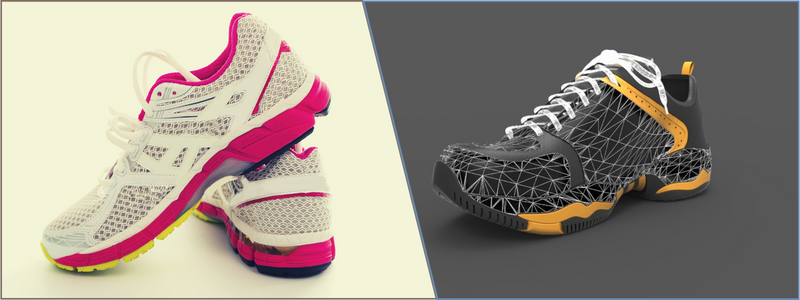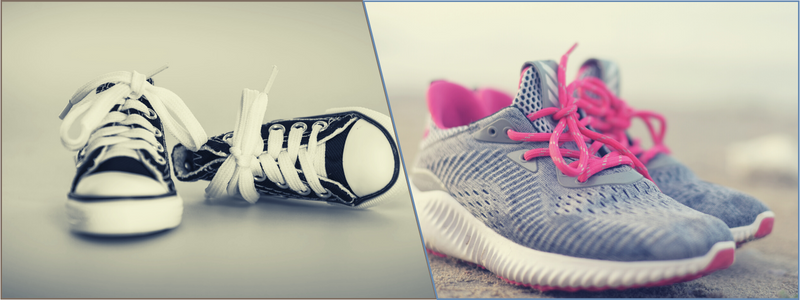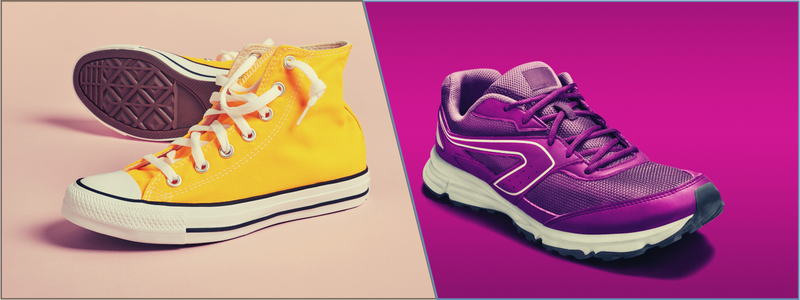This post will discuss making a prototype for shoes, runners, and sneakers using a design service company. Have you ever wondered how your favorite shoe is created? This post will show you how to make a prototype for shoes, runners, and sneakers with a 3D design services company. Shoes, runners, and sneakers go through a lengthy process before they reach the end user. Please continue reading below to learn the details of the process of shoe development and what it takes to go from conceptualization to fully functional shoe prototypes.
What is a prototype for shoes?
A prototype for shoes, runners, and sneakers is a shoe model developed to showcase the features and design of the shoe. Shoe prototypes are used to communicate the intended use and design of the product to potential partners, investors, and customers.
RELATED: How freelance shoe and sneaker designers can create prototypes & make your 3D models
What does a prototype do?
Prototypes are simple representations of a product, process, or idea designed by a product and concept design company. The prototype is typically used to test an invention’s feasibility or concept before it is fully developed. Shoe prototypes are essential for advertising and marketing because they demonstrate how the product will work without investing in production.
Why make a prototype for shoes?
Prototypes serve as helpful tools of reference for both shoe designers and shoemakers. These prototypes are also made either for marketing purposes or submission to buyers. For designers, this gives them a chance to verify and check the quality of work and stipulate adjustments. In addition, this phase also provides a better idea of the costs of the final products. There are several notable advantages associated with shoe prototyping, and these include the following:
- Prototyping shoes, sneakers, and runner shoes design services provide an opportunity to get feedback from other people on how they want or expect your product’s function or design.
- Shoe prototypes give you a chance to conduct tests before the start of manufacturing to prevent surprises once the production officially begins.
- Rapid prototyping lets you develop something accurately and quickly that you can present to your target market or audience.
RELATED: Shoe prototype rates, sneaker design costs & runner 3D modeling pricing for companies
How to make a prototype for shoes
For starters, you need to prepare and document your shoe designs with a detailed agreement with the shoe manufacturer. Your creation must undergo a series of adjustments before they become wearable products.
1. Shoe last development and pattern making
Shoe last development refers to the foot mold or the physical imitation of the human feet that will give shape to the shoes. Pattern-making is the second step, which involves a 2D representation of the shoe design. This includes a specific shoe visualization on a paper based on the last. This pattern will then go to the mockup shoe’s basis.
RELATED: Accessible design: better products for everyone

2. The mockup shoes
The 3D product modeling service will then use the mockup shoe model to develop a prototype that resembles the desired product. These mockup shoes are typically not wearable, and the components can be low-quality or waste materials, often paper. Mockups give shoemaker professionals a substantial preview of how the shoes will appear. Aside from this, a mockup allows designers to understand the shoe design and physical feasibility. This is the specific stage where input is deemed critical for the subsequent steps in the shoe production process.
3. Final sample shoe prototype
Every shoe design begins with a shoe sample or a prototype, which means that a prototype represents shoe production. As far as the manufacturers of shoe prototypes are concerned, shoe prototyping should begin after assessing the compatibility of the production technologies, designs, and materials. The shoe sample embodies the aesthetic and functional features of what will be deemed closest to becoming the final product.
RELATED: How-to guide: new product design, engineering, and prototyping your idea for mass manufacturing
4. Amendments, suggestions, and approval
Once the 3D product animation company invites you over for the evaluation or checking of the shoe prototype, this is the time for you to express your final suggestions and amendments. After you approve the design, the prototype can be sent to the final production stage.
Creating a prototype for runners with a Design Services Company
Design services companies can bring your shoe designs to life starting from the development of the prototype. A rapid prototyping service process is the most crucial step in developing a new collection of shoes before you make an order for production. The design services company will transfer your shoe designs to the physical prototype samples, where you can evaluate design details through models before the sales sample manufacturing.
RELATED: How to make a prototype for your new product design
The prototyping process consists of choosing the shoe heel and material, making the 2D pattern, developing custom molds for the heel, creating the embellishments and hardware elements, and creating the shoe last. An experienced design services company will work with you from the initial prototype concept to the final product, which will help you focus more on the growth and expansion of your brand.
1. Material selection
The outlook of every runner’s style depends on the material selection, and the texture and quality of the material are critical to success and must be considered accordingly. At this stage, you may decide to use high-quality handmade products for your runners. You can customize materials, textures, colors, artwork, hand-beading uppers, special texture hand-weave, and more. The 3D rendering design team will inspect materials before manufacturing to ensure the utmost quality.
RELATED: Different kinds of prototypes and how to use them for your design project
2. Heel selection
Heels are essential for runners and are critical in the process of shoemaking. The shoe last is made on the base of the heel, so choosing the right height and shape before you create the shoe last is necessary. You can choose from a large selection of available heel heights and shapes in different materials, and some companies are open to customized heel molds.
When designing a unique heel that features the brand’s logo, your best option is a customized heel mold. The technician will create the 3D drawing according to the design specifications, and the customer then approves the general construction of the heel. Following the 3D CAD design company’s approval, the customized heel mold will be produced.
RELATED: 6 Ways you can use 3D printing services to create a new prototype design
3. Shoe last creation
The shoe’s last creation refers to the foot form that shoemakers or fashion designers use in the shoe molding process, and this is the anatomical replica of human feet. There are different shapes and sizes of shoes, which can be made from various materials. Plastic, wood, and aluminum materials create the shoe last, with plastic being the most common. Last is exclusively used in the process of shoemaking. This is the first tool used in making runners and will continue to be used throughout the shoemaking process.
The last creation involves transferring the design to foot mold. Once the shoe last is completed, this should give you a better idea of the appearance of the shoes upon completion. The shoe’s last for women will depend on the shoe style and the heel’s shape, and every shoe style construction will also have a different previous form.
RELATED: Top tips to create impactful prototype designs for company products

4. 2D pattern making
2D pattern making is developing the shoe upper using different parts of the lining and upper. Pattern making also extends to the other components, such as the wedge, heel covers, insole, and other features. Pattern makers sketch the shoe design on paper or a shoe last and then convert it to a series of 2D shapes known as pattern pieces. These pattern pieces are essential during the entire process of shoemaking. At first, these patterns are made in one sample size, exclusively for the prototype. These are then graded to cover the complete size range of shoes for production.
The shoe size will change, but the design will remain the same. The prototype sample is developed after the 2D pattern is finished. This is the trial sample to check the fit, construction, and design. These prototype samples can be made using the available colors in the appropriate quality of materials.
RELATED: 6 Reasons you need to prototype your new product design
How to make a prototype for sneakers
Below are the primary steps that you need to begin prototyping new sneakers:
1. Be creative
Being creative and deciding which shoes you want is the first step in prototyping. For example, this includes selecting the material, color, style, heel shape or height, etc. The next step is to create a mockup and design you are satisfied with using online templates.
2. Choose the materials
You can then decide on the materials that best suit your design. Fabric and leather are two of the most common materials that require extra steps before prototyping. When unsure, you can start with canvas or leather and then go from there. You also need to decide on the style and size you want.
RELATED: How 3D modeling services are changing the fashion industry
3. Look for a manufacturer
This is now the time to look for a manufacturer. At this stage, you should be familiar with the design and materials that will work best so that the manufacturer can source the materials. You also need to know the material quality that you want your sneakers to be made out of. To compare quality and prices, you may request quotes from several manufacturers before you proceed.
4. Find an engineer
A design engineering professional is worth consulting if you create complex sneakers or need to make your tooling. When searching for engineers, choose one who is experienced with the design and material of your sneakers.
RELATED: Find the best prototype engineering firm services
6. Inspect the prototype
Inspect the prototype to ensure no features or details are missing from your prototype, and confirm that it is made using high-quality materials. Collect feedback on whether the shoes feel comfortable and how they can be improved.
7. Order the shoe samples
Once your final prototype is approved, you will want to order samples to test material combinations and colors.
What materials can be used for shoe prototyping?
Foam rubber and plastic are commonly used to make shoe prototypes. However, you can also use paper and wood prototypes. Wood prototypes offer plenty of shaping options because wood doesn’t warp when exposed to heat. Alternatively, paper is easy and inexpensive to modify.
RELATED: A product design guide for freelancers developing an invention

Choosing the materials to prototype shoes, runners, and sneakers
Selecting suitable materials to prototype shoes, runners, and sneakers is critical. You need durable and rugged materials that endure various wear and tear levels. Here are a few tips to help you pick the suitable materials for shoe prototyping:
- Select 1-2 parts of the shoe to create in the prototype (i.e., upper pattern, sole pattern, midsole pattern, or top of the heel or shank).
- Using a material such as plaster is one way to cut costs. You can cheaply order plaster in bulk from an arts and crafts shop.
- For plaster prototypes, determine production preference for layers of materials required for the intended shoe part.
- Before you invest in labor and manufacturing costs, you should make prototypes that closely resemble your final product.
RELATED: From idea to reality: turning your invention into a product
Things to consider before you prototype shoes, runners, and sneakers
A prototype is usually a physical representation of a concept or idea that offers valuable information on how to proceed with your design process or project.
- To know if shoe prototyping is a good option for you, here are a few things you need to consider:
- The shape and size of your product may change down the line.
- You must check what materials work best in some conditions, such as temperature.
- You need to test out the user experience and ergonomics.
- Your production techniques cannot assure quality standards in the development process.
- You like to test a few different options.
How Cad Crowd can help
Contact us today for a free design quote on your project if you need design help to bring your new product to life.
